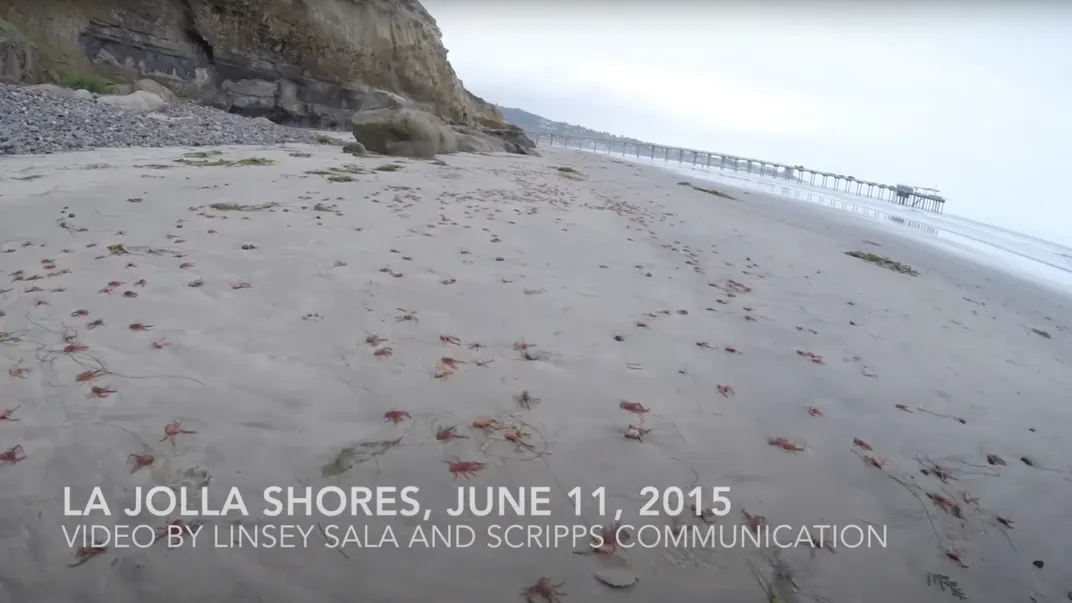Why Are Tuna Crabs Swarming Off the Coast of San Diego?
Scientists are perplexed by the massive group of crustaceans, but they suspect the animals were pushed north by strong ocean currents originating near Mexico
:focal(1500x900:1501x901)/https://tf-cmsv2-smithsonianmag-media.s3.amazonaws.com/filer_public/0d/9f/0d9f6edd-8639-422a-bbcd-a66afe1dae80/gettyimages-1540446.jpg)
Usually, when scuba divers explore the waters off San Diego, they see lots of fish—and maybe the occasional shark or octopus. But, in recent weeks, they’ve found the seafloor completely covered in small, red crustaceans.
The plentiful creatures are called tuna crabs (Pleuroncodes planipes)—they’re related to hermit crabs but are actually a type of squat lobster. Measuring one to three inches long, these bright animals can fit in the palm of a human hand.
Tuna crabs typically live in the waters off Baja California, Mexico. But, for at least the third time in ten years, they’ve been swarming farther north, near Southern California.
It’s not totally clear what’s causing the unusual throngs of tuna crabs outside their normal territory. Sometimes, they even wash up on beaches in droves, which scientists have described as a “striking and puzzling phenomenon.” But the crustaceans’ recent appearances near San Diego suggest “something different is happening in the ocean,” says Megan Cimino, a marine scientist at the University of California, Santa Cruz, to the New York Times’ Jules Jacobs.
“When we think about climate change, the first thing to come to mind might be warming temperatures, but climate change can result in more variable ocean conditions,” she adds.
Scientists have previously linked tuna crab swarms to stronger-than-normal ocean currents that start near Baja California. Sometimes, those strong currents align with El Niño, but not always.
Tuna crabs are susceptible to ocean currents, because they are not strong swimmers, spending part of their lives floating up through the water column, where they feast on plankton. (This also makes them vulnerable to predators, such as tuna, which is how the crustaceans got their common name.)
“It’s not that the crabs are deliberately making their way to us,” says Charlotte Seid, a marine biologist who manages the benthic invertebrate collection at the Scripps Institution of Oceanography at the University of California San Diego, to NBC 7 San Diego’s Danielle Smith. “They live in those waters and get swept up, sort of like birds outside of their migration route, and they find their way to California, even farther north than us.”
Tuna crab swarms are far from the only mystery marine biologists are trying to solve right now. Starving and dehydrated brown pelicans are turning up in droves on California beaches, without a clear cause for their anguish. In Florida, meanwhile, smalltooth sawfish and other fish are dying and exhibiting troubling behaviors, including whirling and spinning in the water. And in Australia last month, 160 long-finned pilot whales inexplicably became beached on the country’s western coast. (All but about 30 of the whales were saved.)
For now, the tuna crabs carpeting the seafloor are providing local predators—including birds, squid, whales, porpoises and large fish—with a plethora of easy calories. But, eventually, those that don’t get eaten will either wash up on shore, like they did in 2015, or get pushed back out to sea.
“The crabs start to die because the local waters are much cooler,” Michael Shane, a marine ecologist at the Hubbs-SeaWorld Research Institute, told ABC News in 2015.
“It’s not entirely alarming, but it has been unusual to see them in these numbers year after year,” Seid tells NBC 7.
In the meantime, the crabs are creating a ruddy-hued spectacle for divers.
“It was interesting for me personally as a recreational scuba diver to see so many of them alive, seeing them interacting with other species,” Seid tells CBS 8’s Brian White. “Recently I saw a little baby octopus chewing on a dead one, so kind of keeping that food chain going.”
/https://tf-cmsv2-smithsonianmag-media.s3.amazonaws.com/accounts/headshot/SarahKuta.png)



/https://tf-cmsv2-smithsonianmag-media.s3.amazonaws.com/accounts/headshot/SarahKuta.png)